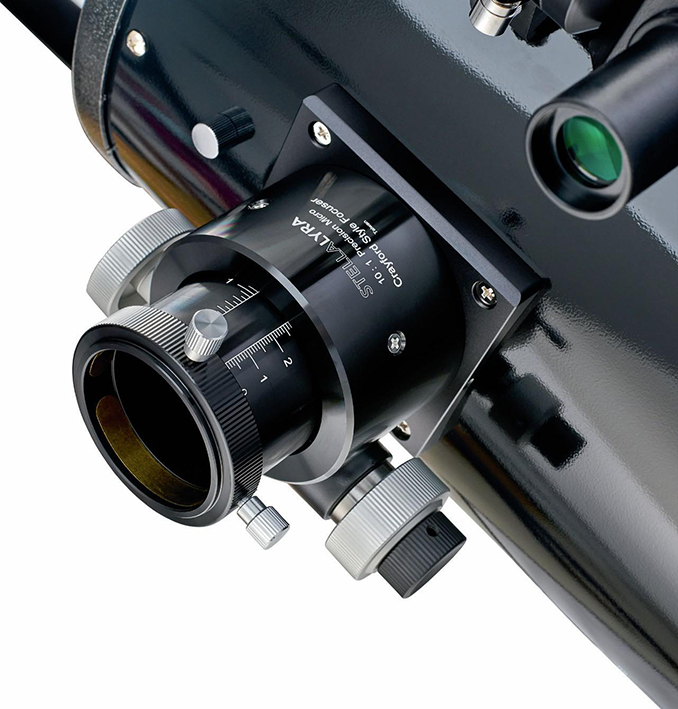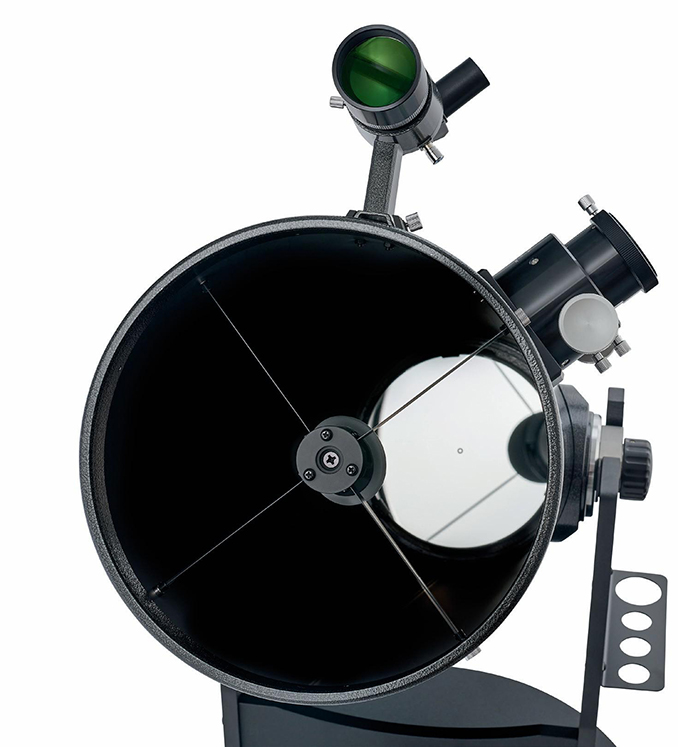The light-bucket with a touch of class – Astronomy Now

Based in Exeter, First Light Optics (FLO) sells an impressive range of reflecting telescopes under its own StellaLyra brand. Encompassing Newtonian, classical Cassegrain and Ritchey–Chrétien optical configurations, these instruments are designed and manufactured for FLO by Guan Sheng Optical (GSO) in Taiwan –a company with a long-standing reputation for high-quality workmanship and innovative design.
For the most part, FLO’s StellaLyra telescopes are sold as optical tubes and accessories but without mounts. The exception is their suite of 150 to 400mm (6- to 16-inch) Dobsonians, which contain everything that you need to observe straight out of the box. For the purposes of this evaluation we chose the model that sits squarely in the middle of the range, the ever-popular 250mm (10-inch), f/5.
With the exception of the largest StellaLyra Dobsonian, which is a 400mm truss-tube design, the range possesses one-piece rolled steel tubes.
While this does mean that they may be a little heavier and more cumbersome than competing flex-tube or truss-type implementations, many people prefer the optical protection and rigidity afforded by a solid optical tube assembly that reduces the accumulation of dust on the mirrors (since the tube is sealed when not in use), improves contrast in heavily light-polluted environments, and helps keep dew at bay.
All StellaLyra Dobsonians of 200mm aperture and larger come with two fully multi-coated eyepieces and a large-aperture, right-angled, correct-image finderscope to save you from getting a cricked neck. Furthermore, the mounts of all but the 150mm aperture model possess deluxe altitudeaxis bearings with tension and balance adjusters, plus a roller-bearing azimuth system, also with tension adjustment. These advanced features put the StellaLyra instruments squarely in premiumclass Dobsonian territory.
Delivery and assembly
The StellaLyra 250mm model is couriered to your door in not one, but two boxes. The largest, containing the optical tube and accessories, is 49 × 50 × 141 centimetres in size, grossing 20 kilograms. The smaller box containing the Dobsonian mount in flatpack form is 64 × 64 × 14 centimetres and tips the scales at 15 kilograms. So it pays to have an extra pair of hands to help you unpack and assemble the telescope. That said, the only part of the instrument requiring a modicum of DIY is the Dobsonian altazimuth base; the optical tube is pre-assembled with the exception of the altitude bearings, which I’ll return to presently.

The review unit didn’t come with any assembly instructions, but a quick check of the relevant page of First Light Optics’ website revealed a downloadable PDF. If you’re not prepared to consult the five-page PDF on your smartphone, it might be a good idea to ask FLO to ensure a paper copy is included. Fortunately, the assembly instructions are clear and easy to understand. Most of the mount itself is fairly standard Dobsonian fare in terms of construction materials, namely plasticcoated particleboard.
Owing to Mrs A’s penchant for Scandinavian flat-pack furniture, I consider myself something of a wizard with an Allen key (supplied, though you’ll need a cross-head screwdriver too). According to the stopwatch, I built the altazimuth base in 17 minutes and completed assembly in 25 minutes overall. Having built numerous Dobsonian bases over the years, I may have a bit of an advantage, so I would clear a large space in the living room and set aside at least 45 minutes to complete the task.

The StellaLyra suite of 150 to 400mm (6- to 16-inch) Dobsonians contains everything that you need to observe straight out of the box
Mount refinements
As mentioned earlier, there are some refined features of the mount worthy of note. Unlike most budget Dobsonians, the azimuth bearing is not simply a base board with a central bolt and three pieces of slippery Teflon gliding against the underside of the mount. Rather, the 200mmaperture-and-larger StellaLyra Dobsonians use a needle roller-bearing sandwiched between two 32-centimetre-diameter metal-bearing plates.
A tensioning knob (with its own small thrust bearing) threaded through a centre bushing joins the top baseplate, azimuth roller-bearing and ground baseplate. Hence, rather like a clutch, the tensioning knob can adjust the stiffness and freedom of motion left to right, which is a good thing as without it the azimuth axis is almost too smooth and the telescope revolves at the slightest touch!
On either side of the optical tube lie two lozenge-shaped face plates, each with graduated scales and milled channels containing captive bolts designed to accept the left and right altitudebearing assemblies. Each bearing has a beefy clutch knob to adjust the freedom of motion and two bolts that, when unlocked with the supplied Allen key, permit the bearings to move towards or away from the primary mirror over a 63.5mm range.

The StellaLyra 250mm, f/5 Dobsonian is clearly an instrument that lives up to GSO’s reputation for fine optical performance, bundled with good quality eyepieces and a superior 8 × 50 rightangled correct-image finderscope
By moving the altitude bearings fore or aft you can precisely balance the tube according to the weight of the eyepiece and accessories in use, the graduated scales on either side ensuring that the altitude axis is perpendicular to the tube. This is really important if you wish to use digital setting circles at a later date (see the end of this review for more about this). Each bearing assembly has a U-shaped alloy casting that merely slots into the top of the mount’s side panels for quick deployment.
Despite the commendable altitude- and azimuth-axis enhancements, there are minor niggles. Since the size of the azimuth needle roller-bearing is 32 centimetres in diameter, why make the mount’s baseplate 56 centimetres in diameter, which is harder to manoeuvre between door frames? Granted, the mount’s side panels need to be braced and 36 centimetres apart to accommodate the tube and side bearings, but slimmer profile side panels would result in a more compact mount.
Without the azimuth-axis tensioning knob locked down firmly to prevent the tube spinning away from the object you’re viewing at the slightest touch, there is some flexure here. That said, vibrations from a sharp rap to the tube dampened in two seconds with the mount standing on patio slabs. And while it’s possible to balance the tube perfectly when horizontal, the tube pitches back when viewing at high altitudes owing to the relatively heavy finderscope; splitting the difference in the balance point and clamping the clutches alleviates this, but at the expense of some smoothness in altitude motion.
Impressions
If there’s any truth to his “any colour – so long as it’s black” quote, then American industrialist Henry Ford would’ve loved this telescope. Its 30.3-centimetre diameter, 1.21-metre long steel tube has an unobtrusive seam underneath and a gorgeous gloss powder coat finish (albeit something of a fingerprint magnet), with charcoal grey, Hammerite-finish, rounded end-rings both top and bottom. The plastic coating of the mount’s particleboard panels has a textured satin finish, with a carrying handle on the front brace and a metal holder for one 2-inch and three 1.25-inch eyepieces on the side.
The assembled telescope tips the scales at close to 29 kilograms, 16 kilograms of that being the tube assembly alone. Its length means that it can comfortably lie across the back seat of most cars, though the mount may prove to be the most awkward component when transporting it to a dark-sky site. Thankfully, the Dobsonian is very tolerant of being moved. In fact, the instrument was almost perfectly collimated straight out of the box, which speaks volumes for GSO’s quality control and fine mirror-cell design.
The primary mirror consists of a BK7 glass mirror blank, 250mm in diameter with a clear aperture of 246mm, allowing for the chamfered edge. The primary is permanently centre-marked and sits on cork shims in the cell, with rubber grommets preventing any lateral or front-to-back flop. Around the circumference of the primary cell you find three spring-loaded, black hand-knobs for collimation, and three white hand-knobs to lock down the mirror after alignment is achieved. A mirror cooling fan operates from the 12V battery pack provided (AA cells extra).
At the other end of the tube, the four metal vanes of the secondary support are nicely tensioned and very thin (approximately 0.7mm) to minimise diffraction…
Read More: The light-bucket with a touch of class – Astronomy Now

